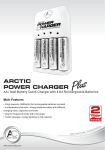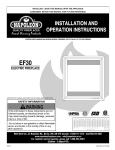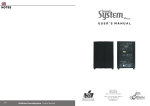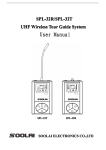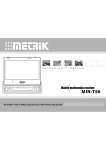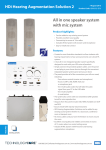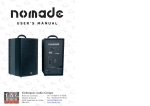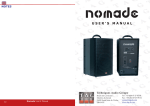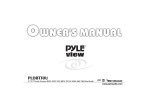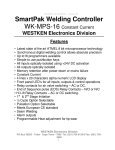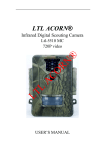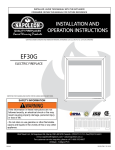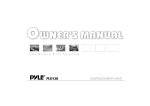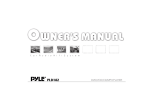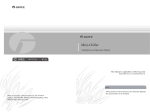Download INFRARED WIRELES TEACHING AMPLIFIER SYSTEM
Transcript
INFRARED SOUNDFIELD SYSTEM IR-89 User Guide Thank you for buying this product. Please read through these operating instructions so you will know how to operate your equipment properly. After you have finished reading the instructions, put them away in a safety place for future reference. TABLE OF CONTENTS 1. SAFETY PRECAUTIONS………………………………………………2﹐3﹐4 2. FEATURES………………………………………………………………5 3. PACKAGE CONTENTS…………………………………………………5﹐6 4. INSTALLING THE SYSTEM……………………………………………7﹐8 5. IR-89 INFRARED SOUNDFIELD SYSTEM, MAIN RECEIVER UNIT………………………………………………………………………9﹐10 6. TRANSMITTER…………………………………………………………11﹐12 7. CHARGER………………………………………………………………13 8. TROUBLE SHOOTING…………………………………………………14 1 9. DIMENSIONS……………………………………………………………14 10. GENERAL SPECIFICATIONS…………………………………………15 Thank you for your purchase of IR-89 Infrared Soundfield System. Before using the equipment, be sure to read this entire operating manual so that you can take full advantage of the IR-89's features. After you finish reading, keep this document and the warranty handy in a safe place in case you need them in the future. The manual should be very helpful in understanding the system and solving any difficulties that may arise during use. SAFETY PRECAUTIONS To ensure proper use of the equipment, carefully read the Safety Precautions prior to use. Icon Labels A variety of icon labels are used in these Safety Precautions section to ensure safe and proper use of the product, to prevent injury to yourself and others, and to prevent property damage. Make sure you fully understand the meanings of the icon labels as you read the manual. Warning This label is used in cases where there may be a possibility of death of serious injury if the label is ignored and the equipment is used improperly. Caution The label is used in cases where there may be a possibility of injury or just physical damage if the label is ignored and the equipment is used improperly. a. A fire or electric shock may result if the equipment is used under abnormal conditions (e.g., if it is emitting smoke, or strange odors or noises). In such cases, immediately remove the power plug from the outlet. Make sure the equipment stops emitting smoke, then contact your dealer to have it repaired. b. If water enters the equipment, first turn off the equipments' power switch and remove the power plug from the power outlet, then contact your dealer. Using the equipment under such conditions may result in fire or electric shock. c. If a foreign object enters the equipment, first turn off the equipment's power plug from the power outlet, then contact your dealer. Using the equipment under such conditions may result in fire or electric shock. 2 d. If you drop the receiver or damage its cabinet, remove the power plug from the power outlet and contact our dealer. Using the equipment under such conditions may result in fire or electric shock. e. If the power cord is damaged (e.g., If the core wire is exposed or if the cord is broken), have the cord replaced by the dealer. Using the equipment under such conditions may result in fire and electric shock. f. Do not use the equipment at voltages other than the supply voltage. Doing so may result in a fire or electric shock. g. When you install the equipment, leave a gap of at least 10cm between it and the nearest well. Also make sure there is a bit of space between it and the other equipment to ensure proper heat dissipation. If you install the equipment on a rack, make sure there is at least 2cm of free space above the unit, and at least 5cm behind it. If there is not enough free space around the unit, heat may build up inside of it, possibly result in a fire. h. Do not use the equipment near bathing areas. Doing so may result in fire or electric shock. i. If there is lightning near the equipment, do not touch its power plug. Doing so may result in electric Shock. j. Do not allow water to enter the equipment or allow it to get wet. Doing so may result in a fire or electric shock. Be especially careful when using e equipment when it is raining or snowing, and when using it near the ocean or other large bodies of water. k. Do not set flower vases, plant pots, cups, cosmetics, medicines, or any container filled with water or other liquids, or small pieces of metal, on top of the equipment. In such case, fire or electric shock my result if the liquid spills on the equipment or metal enters it. l. Do not set candles or other flame sources on top of the equipment. Doing so may result in fire. m. Do not attempt to charge dry cell batteries. Doing so may result in fire or injury if the batteries burst or Leak. n. Do not connect the equipment to a direct current (DC) power supply on ships or the like. Doing so may result in fire. o. Do not block the ventilation holes on this equipment. If the ventilation holes are blocked, heat may build up inside the equipment, possible resulting in a fire. There are ventilation holes on the top and bottom of the equipment's casing in order to prevent the internal temperature from rising. Do not use the equipment in any of the following ways: Do not set the equipment so that it faces upward, or set it on its side, or turn it upside down. Do not fit the equipment into a bookshelf (except for a special rack), closet or other space with poor Ventilation. Do not place a tablecloth, rug, or bedspread on top of the equipment and attempt to use 3 p. q. r. s. the equipment. Do not set anything heavy on the power cord, or place the cord under the equipment. Doing so may damage the cord, possibly resulting in a fire or electric shock. If the cord is placed under a carpet or the like, somebody may not notice the cord and set something heavy on top of it. Do not insert or drop in anything metallic or flammable through the disc insertion slot on the equipment. Doing so may result in fire or electric shock. Be especially careful if there are small children in our household. Do not damage, modify, excessively bend, twist, or pull on the power cord. Doing so may damage the cord, possibly resulting in a fire or electric shock. Never remove the equipment's back lid, cabinet, or cover The equipment contains high-voltage components which could cause electric shock if touched. Contact your dealer for internal checks, maintenance, and repairs. t. Do not modify the equipment. Doing so may result in fire or electric shock. Caution a. Do not install the equipment in smoky or steamy locations, such as near kitchens or humidifiers. Doing so may result in fire or electric shock. b. Do not install the equipment in an unstable location, such as a wobbly mount or on a slanted surface. The equipment may fall of or tip over if installed in such locations, resulting in injury c. Do not place the power cord near a heater. In such cases, the cord sheathing may melt, resulting in fire or electric shock. d. Do not leave the equipment in a location that could become extremely hot, such as inside an automobile when the windows closed or in a location exposed to direct sunlight. Doing so may adversely affect the cabinet and components, possibly resulting in a fire. e. Do not install the equipment in humid or dusty locations. Doing so may result in a fire or electric shock. f. When removing the power plug, do not pull on the power cord. Doing so may damage the cord, resulting in fire or electric shock. Always grasp the plug as you remove it. g. Do not move the system with equipment such as a television or audio equipment on top of it. The system may tip over or fall off, possibly resulting in injury. 4 h. Do not climb on or hang from the equipment. The equipment may tip over or damaged, possibly resulting in injury. The caution is especially important for children. i. Do not set anything 5kg or heavier on top of the equipment. Also do not set anything on the equipment which protrudes beyond the edges of the equipment. In such cases, a loss of balance may cause the object to tip over or fall, possibly resulting in injury j. Do not remove or insert the power or plug with wet hands. Doing so may result in electric shock. k. If you plan to connect audio equipment or other equipment to the system, carefully read the operating manuals provided with that equipment. Turn off all equipment power and connect the equipment according to the instructions in the manuals. Only use the designated cords in connecting the equipment. Using cords other than those designated or using extension cords may cause heat to build up, possibly resulting in burn injuries. l. Before turning on the equipment, set the volume to the lowest setting. At a high volume setting, the sudden loud output noise could damage your hearing. m. If you are not going to be using the equipment for an extended length of time, remove the batteries. Leaking batteries could cause fire, injury, or damage to the surrounding. If a battery leak occurs, thoroughly wipe the fluid from the battery case, and then insert a new battery. If battery fluid gets on you, thoroughly rinse it off with water. n. To prevent accidents, install the equipment near a power outlet so that it can be unplugged immediately. o. Contact your dealer about once every five years to have the equipment's interior cleaned. If dust builds up inside the equipment and it is not cleaned for an extended length of time, fire or injury may result. Ask your dealer This type of cleaning is especially effective prior to the rainy season, when humidity rises. for prices on leaning service. p. If you are not going to be using the equipment for an extended length of time (e.g., if you go traveling), be sure to remove the power plug from the outlet as a safety precaution. Failure to do so may result in fire. q. Before moving the equipment, turn off the power switch, and be sure to remove the power plug from the outlet and disconnect any antennas and cords (such as cords connecting different pieces of equipment). If this is not done, the cords may be damaged, resulting in fire or electric shock. r. Before cleaning the equipment, remove the power plug from the outlet as a safety precaution. FEATURES ◆ ◆ ◆ Main receiver unit can be free-standing or rack mountable with 1 3/4”rack space. Four 25 watt amplifiers with eight speaker output connections. Individual volume control for each amplifier output. 5 ◆ ◆ ◆ ◆ ◆ ◆ ◆ ◆ ◆ ◆ Page override technology, speaker level switchable (24V, 80V or 100V) Dual channel infrared receiver allows two microphone transmitters to be used at once. Four auxiliary line inputs (stereo) with volume control on the front panel. Front panel line output for personal listening system with gain control. Real Panel line output (stereo). Nine band graphic equalizer. Three external sensor inputs. A compressor and expander are used to provide a wide dynamic range. A tone squelching circuit it is used to eliminate unpleasant noise when a wireless microphone is tuned on and off. A noise muting circuit is used to eliminate unpleasant cracking noise when a wireless microphone moves the maximum distance away from the receiver. PACKAGE CONTENTS The package contents are shown below. Make sure the package contains all of the contents show here. (1) IR-89 Infrared Soundfield System, Main receiver unit (1) Adaptor for IR-89 (1) IRS-30 Infrared dome sensor (1) ISC-15 Infrared sensor cable, length-15meters 6 (2) Wall Mount Speakers (1) ISH-30 Ceiling bracket kit for IRS-30 (1) IRM-99 Infrared handheld microphone (1) IRT-1 Infrared bodypack transmitter (1) Rechargeable battery for IRM-99, Ni-MH type 2.4V / 26500mAH (2) Rechargeable battery for IRT-1, Ni-MH type 1.2V / 2650mAH Accessory for IRT-1 (1) LM-10 Lapel microphone for IRT-1. or (1) HM-20 Headset microphone for ITR-1 or (1) PM-30 Plug in microphone for ITR-1 7 (1) Charger CHR-306 (1) Adaptor for CHR-306 (1) User Manual Alternative sensors (1) IRS-02 Infrared wall sensor (1) ISH-02 Wall bracket kit for IRS-02 (1) ISC-05 Infrared sensor cable, length-5meters (1) ISC-10 Infrared sensor cable, length-10meters INSTALLING THE SYSTEM System and Connection Diagram Install the infrared sensors in high locations so that the infrared sensors will have line of sight over the entire room and the emitter light from the transmitters is not blocked by people or other objects. Installation example(as seen from above) 1. 8 2 Connect the power cord to the system and to the power outlet. Connect the infrared sensors to the back panel sensor inputs of the main system using the supplied coaxial cable. Then connect the speakers to the speaker outputs. Turn on the receiver then adjust each volume knobs to the desired volume. 9 INSTALLING THE INFRARED SENSOR Attaching the infrared dome sensor Installation 1 1. Screw the sensor into the bracket to attach it. 2. Attach the sensor bracket to the ceiling using the screw shown in the illustration. 3. Connect the sensor cable to the sensor and tighten securely. 4. The sensor better be installed horizontally face down to the floor. Installation 2 1. Remove the ceiling tile and drill a hole about Ø 20 mm in it. 2. Push the screw through the ceiling tile and screw them into the ceiling censor by using the two long screws (Ø 3x25mm) provided. 3. Connect the sensor cable to the sensor and tighten securely. 4. Return the ceiling tile and make sure everything is firm and steady. Attaching the infrared wall sensor 1. Attach the sensor bracket to the wall using the screws shown in the illustration. 2. Slide the sensor into the bracket to attach it. 3. The sensor can be attached to the bracket from four different directions. 4. The sensor better be installed horizontally face down to the floor. 10 INFRARED SENSOR INSTRUCTION Connection indicator When the infrared sensor is plugged into a sensor input jack, the indicator light turns red. The connection indicator light does not turn on if there is a connection problem between the jack and the connector, or if the cable is broken or short - circuited. Therefore, if the indicator light does not turn on, check the infrared sensor connection, etc. The sensor and sensor cable should be kept away from CRT televisions, plasma televisions, fluorescent lights, spotlights, neon lights, and the like. Doing so may create noise, possibly damaging your speakers or hearing. 11 Keep the sensor away from the special charger CHR-306. If the sensor gets close to the charger, noise can occur and may damage the speakers or your hearing. Caution: 1. Make sure the sensors are not installed behind anything. 2. Noise may occur if there are obstacles between the microphone and the sensors. If you speak or sing loudly into the microphone while noise is occurring, the sound may be interrupted. 3. Noise may occur if the infrared sensors are in the path of sunlight, spotlights, neon light, and other bright light sources. Install the infrared sensors away from bright light sources. 4. Infrared light can pass through glass. Take this into consideration when installing the infrared sensors if there is glass separating the installation room from adjacent rooms. 5. Make sure the attachment location is sufficiently strong before attaching an infrared sensor. If the attachment is too weak or if the infrared sensor is improperly attached, it may fall down. We assume no liability in the case of such accidents. 6. Noise may occur if you use infrared remote controls, infrared headphone transmitters, plasma TVs or the special charger CHR-306 near the infrared sensor. IR-89 INFRARED SOUNDFIELD SYSTEM, MAIN RECEIVER UNIT Front Panel Diagram and Instruction 1. 2. Power switch The Power Switch turns the receiver on (-) and off (O). The red light next to the switch indicates whether the unit is on (-). CH A and CH B Wireless Microphone Volume Control These control the relative volume levels of the two infrared wireless microphone channels. If one of the microphones is too loud or soft relative to other sounds, adjust the 12 knob according. Rotating the knob clockwise increases the output level. 3. IR Indicators The green signal light next to each knob indicates whether that channel is being received. 4. Page Override The yellow light indicates when the page is broadcast. When the school P.A. system broadcasts an announcement, the signal from the P.A. system mutes the inputs to the receiver and passes the page announcement signal through the receiver amplifier and to the speakers. 5. Audio Input Volume These input controls are conveniently located in the front of the unit for easy individual sound sources volume adjustment. COMPUTER: This controls the volume level of a COMPUTER audio signal connected to the rear panel COMPUTER INPUT jack. TV / VCR: This controls the volume level of a TV/VCR audio signal connected to the rear panel TV/VCR INPUT jack. CD / DVD: This controls the volume level of a CD/DVD audio signal connected to the rear panel CD/DVD INPUT jack. AUX: This controls the volume level of an auxiliary input signal connected to the rear panel AUX INPUT jack. 6. Line Out This Line output can be used to transmit the audio to another device, such as an amplifier, a recorder or an assistive learning system. 7. Line Out ADJ This controls the volume level of Line output. Rear Panel Diagram and Instruction 8. Speaker Level Controls The four speaker output levels can be individually adjusted. The corresponding knobs are located on the left to the connectors. 13 9. Speaker Outputs (25W x 4, 4-8Ω) The receiver has 4 speaker output terminals, each one driven by a separate power amplifier (25W). These connectors are used to connect the cable from each speaker (euro-block) to one of these euro-block speaker terminals. When connect 2speakers in a terminal, use 8Ωspeakers to prevent amplifier burn down. 10. 9-Band Graphic Equalizer The equalizer affects the output to the speakers and the line output. The sliding controls adjust the levels of the various audio frequencies. This allows the installer to adjust the overall tone of the sound coming through the speakers and to make the whole system achieve optimum sound quality. 11. Page Input Use cable to connect the school PA system to the PAGE INPUT of the receiver in the rear panel. When the school P.A. system broadcasts an announcement, the signal from the P.A. system mutes the inputs to the receiver and passes the page announcement signal through the receiver amplifier and to the speakers. Four different kinds of page input selectors. The knob on top of the page input controls the volume level of incoming page. 12. Line Output This Line output can be used to transmit the audio to another device, such as an amplifier, a recorder or an assistive learning system. 13. Audio Inputs (RCA connector) AUX: Receive stereo signal from any auxiliary device. CD / DVD: Receive stereo signal from CD/DVD device. TV / VCR: Receive stereo signal from TV/VCR device. COMPUTER: Receive stereo signal from COMPUTER device. 14. Sensor Inputs (RCA connector) There are 3 inputs for infrared sensors on the back of the receiver. The sensors are connected to the receiver via coaxial cable with F type connectors. At lease one sensor must be connected for the infrared receiver to function. Connected additional sensors improve reception and cover lager space. When the sensor is connected to the receiver and the receiver in turned on, the red light on the sensor will illuminate, indicating that the sensor is active. 15. DC IN (19V) Plug the DC19V, 4.75A power supply into this jack. 14 TRANSMITTERS Handheld Microphone IRM-99 Diagram and Instruction Rechargeable battery Ni-MH type 2.4V / 2650mAH x1 1. On / Off Switch 2. Indicator Light on=Green red=Battery Low 3. Channel Selector 4. Battery Compartment 5. Emitter Diodes (Do not block) 6. Battery Compartment Tube Cover 7. Cartridge and Steel Mesh 8. Ring Access Microphone Battery Step1: Unscrew the cover from the lower half of the microphone. Step2: Insert battery with (+)contact toward the bottom side. Be aware of the (+)(-) battery 15 polarity. Step3: Screw the cover back to the microphone compartment tube. Operating 1. Turn on the main unit of the infrared teaching amplifier system and the other equipment. *The system will not receive any signal for approximately 5 seconds after the power is turned on. 2. Remove the battery compartment tube cover and set the channel to the desire one. 3. Turn on the microphones. When the microphone is turn on, the green power indicator light should be illuminated. If the battery is low, this indicator light will turn to red. *Do not block emitter diodes with hand. *Bring the microphone close to one of the infrared sensors and make sure the infrared sensor picks up the microphone signal. (Do this while making sure that the other infrared sensor cannot receive the signals.) If the sensor does not receive the microphone's signal, or if the sensitivity is poor, check the cable connection. Bodypack IRT-1 Diagram and Instruction Rechargeable battery Ni-MH type 1.2V / 2650mAH x2 1. On / Off Switch 16 2. 3. 4. 5. Volume Control Power Indicator Microphone Input Emitter diodes (Do not block) 6. High / Low Power Output Selector 7. Channel Selector 8. Battery Compartment 9. Wire Clip 10. Charging Contacts Access Microphone Battery Step1: Open battery cover. Step2: Insert batteries into the compartment and follow polarity indicators. Be aware of the (+)(-) battery polarity. Step3: Step3: Close battery cover. Operating 1. Turn on the main unit of the infrared teaching amplifier system and the other equipment. *The system will not receive any signal for approximately 5 seconds after the power is turned on. 2. Remove the IRT-1 battery compartment cover and set the channel to the desire one. 3. Plug in the microphone to the transmitter and adjust the microphone distance as close to mouth as possible. 4. Turn on the microphone transmitter and adjust the volume level. When the microphone is turn on, the green power indicator light should be illuminated. If the battery is low, this indicator light will turn to orange. *Do not block emitter diodes with hand. *Bring the microphone transmitter close to one of the infrared sensors and make sure the infrared sensor picks up the microphone signal. (Do this while making sure that the other infrared sensor cannot receive the signals.) If the sensor does not receive the microphone's signal, or if the sensitivity is poor, check the cable connection. 17 CHARGER Diagram and Instruction Top View Bottom View 1. 2. 3. 4. 5. 6. 7. 8. 9. 10. Side View D slots charging and saturated indicator light D slots discharging indicator light C slot charging and saturated indicator light D slot discharging and enforced charging switch B slot discharging and enforced charging switch A slot charging and saturated indicator light B slot discharging indicator light B slot charging and saturated indicator light Microphone support jack C slot charging area ( for handheld microphone use only ) 18 11. B slot charging area (for rechargeable batteries and bodypack transmitter) 12. A slot charging area (for handheld microphone use only ) 13. D slot charging area (for rechargeable batteries and bodypack transmitter) 14. DC12V input 15. Switch for saturated alarm Charging TROUBLESHOOTING If you think there may be a problem with the equipment, perform the troubleshooting checks shown below. Sometimes an unexpected error makes it seem like the equipment is broken. If you are still unable to solve the problem after performing these checks, contact your dealer. Phenomenon 1: No sound Check The wireless microphone battery is dead. The microphone tone frequency does not match. The system and amp speakers are not properly connected. Solution Charge or replace the microphone battery Use microphones with the same tone Check the connection. 19 frequency. Phenomenon 2: Low volume Check The system's volume adjustment is too low. The speakers' output power is not enough. Solution Turn the volume adjustment knob clockwise to set the desire volume. Connect an additional speaker to the speaker terminal. Phenomenon 3: Poor reception sensitivity and Hearing static Check Solution The infrared sensor cable is not properly connected. The infrared sensor is not installed in optimum location or hidden. You are holding the Properly connect the infrared sensor cable. Attach the infrared sensor in a position with line of sigh. Hold the microphone properly. microphone's infrared light emitters Is the mute sensitivity set to "LOW"? Two microphone transmitters Set the mute sensitivity switch to "HIGH". Ensure microphone transmitters are operating on different channel are operating on the same channel simultaneously Notes: 1. Noise or hearing static may occur if the infrared sensors are in the path of sunlight or other bright light sources, or if they are blocked by something. Noise in such cases is a natural occurrence due to the way the infrared sensors work. It does not indicate any problem with the equipment. 2. Noise or hearing static may occur when you disconnect and then connect an infrared sensor while a signal is being received. 3. Noise or hearing static may occur if you turn the power on and off while a signal is being received. 20 DIMENSIONS UNIT:CM GENERAL SPECIFICATIONS IR-89 Infrared Soundfield System Receiving Method Infrared Receiving No. of Channel 2 Frequency Ch A : 2.08 MHz / Ch B : 2.54 MHz Infrared Wavelength 850 nm Modulation FM wide-band De-emphasis 50μS Frequency Response 50Hz ~ 15KHz S/N Ratio > 65dB THD <1%@1KHz Nominal Deviation ±10KHz 21 Maximum Deviation ±25KHz Input Level 1V / 1KΩ Input 4 terminals, AUX, CD / DVD, TV / VCR, computers with RCA connectors Amplifier Output 100W Speaker Terminal Terminal Block connectors, 8Ω speaker x 8pcs or 4Ω speaker x 4pcs Receiving Range 20m line-of-sight External Sensor Input Could connect up to 3 external sensors, RCA type. Output 1(front) 3.5mm phone jack, 1(rear) RCA connector Power Supply DC 19V / 4.75A Size 429(W) × 42(H) × 181(D)mm Weight Approx. 1.38kgs IRM-99 Infrared Handheld Microphone Model No. IRM-99 Transmission Carrier Infrared Modulation FM Carrier Frequency Ch A : 2.08 MHz Ch B : 2.54 MHz (Switchable) Ch C : 2.30 MHz Ch D : 2.80 MHz (Switchable) Pilotone Frequency 32.768 KHz (A.B ch.) or 38.000 KHz (C.D ch.) IR Wavelength 850 nm Peak Deviation ± 25KHZ No. of IR emitting Diode 10 pieces Compander Circuit Yes Pre-emphasis 50μS Location of IR Emitter Built-in Transmission Angle 360° Current Consumption 330 mA Microphone used Unidirectional Dynamic Battery Life approx. 6 hours Battery Used Rechargeable NI-MH type 2.4V / 2650 mAH x 1 Dimensions 247(L) x 45(dim.) mm 22 250g Weight IRT-1 Infrared Bodypack Transmitter Type Bodypack Model number IRT-1 Transmission Carrier Infrared Ray Carrier Frequency Ch A : 2.08 MHz Ch B : 2.54 MHz (Switchable) Ch C : 2.30 MHz Ch D : 2.80 MHz (Switchable) Modulation FM Pilotone Frequency 32.768 KHz(A.B ch.) or 38.000 KHz (C.D ch.) IR Wavelength 850 nm Peak Deviation ± 25KHZ No. of IR emitting Diode 10 pieces Compander Circuit Yes Pre-emphasis 50μS Location of IR Emitter Built-in Transmission Angle 360° IR Power Output selection HI (Hight) LO (Low) Current Consumption HI-400 mA, LO-330 mA Range HI about 30m , LO about 20m Microphone input Socket(MIC IN) 3.5 mm mono phone jack Microphone used Lapel / Headset / Plug-in Battery Used Rechargeable NI-MH type 1.2V / 2650 mAH x 2 Battery Life approx. 7 hours Dimensions 110(L) x 63(W) x 20(H) mm Weight 78g IRS-30 Dome Sensor Operating frequency 2MHz to 2.6MHz 23 Operating range 20m line-of-sight Signal / Power interface RCA type Number of IR LED 30 Reception area 232m / 2500ft Power indicator LED Red Reception angle 360°full semi-spherical(half dome) coverage Dimensions 33(DIA) x 39(H) mm Weight 160g Operating frequency 2MHz to 2.6MHz Operating range 20m line-of-sight Signal / Power interface RCA type Number of IR LED 15 Reception angle 120°horizontally / 120°vertically Power indicator LED Red Dimensions 65(DIA) x 29(H) mm Weight 35g (without Cable) CHR-306 3 in 1 Drop-in Charger Charging Slot A/B/C/D Charging Mode Switching Charging Current 800mA ±10% Discharging current 350mA Charging Indicators Red = Charging, Green = Full, Yellow = Discharging, Blinking Orange = Charging Standby Switchable Discharging(yellow) / Charging(red) button for B and D slots (use for Bodypack or rechargeable battery) Automatically switch to charge(red) mode when discharge Complete Discharging Method Auto Switching Charging Time 3~4hr/ slot Power Supply DC 12V / 1.2A 24 Dimensions 165(L) x 85(W) x 35(H)mm Weight 320g (with microphone holders and adapter) Please record your system serial numbers. This information is helpful when ordering additional components, accessories, and requesting warranty service. 25 26


























